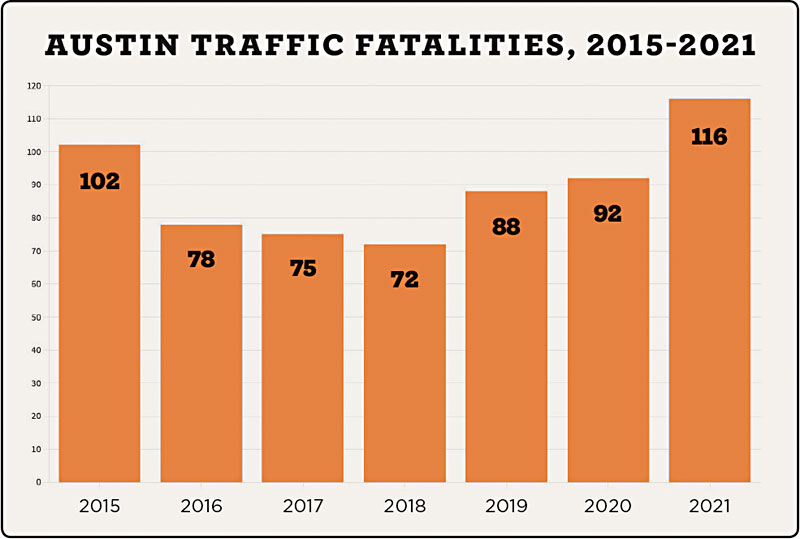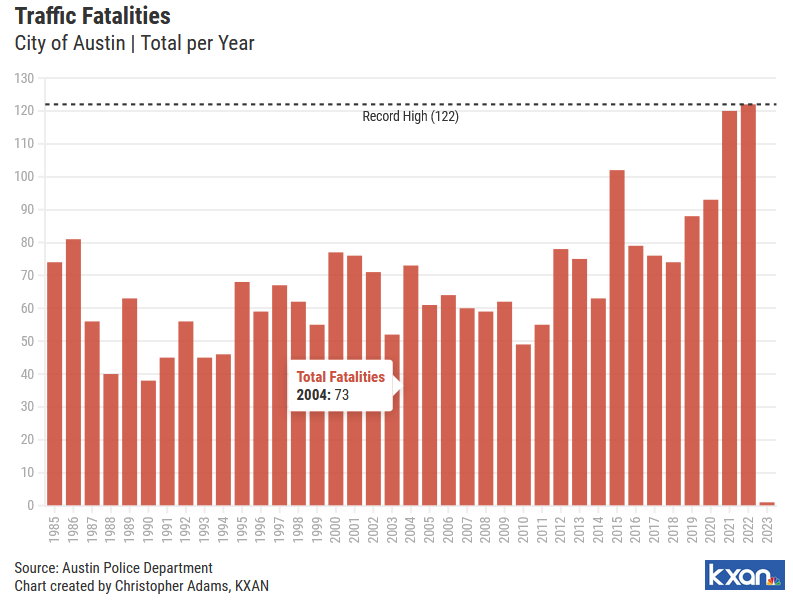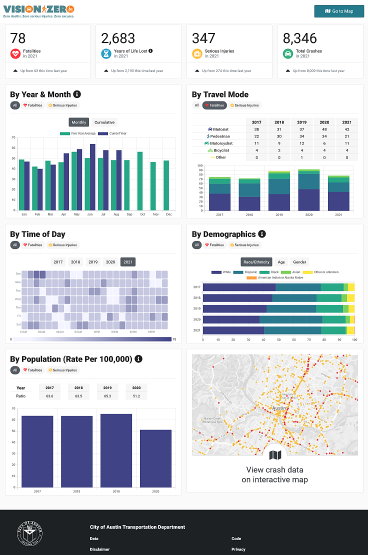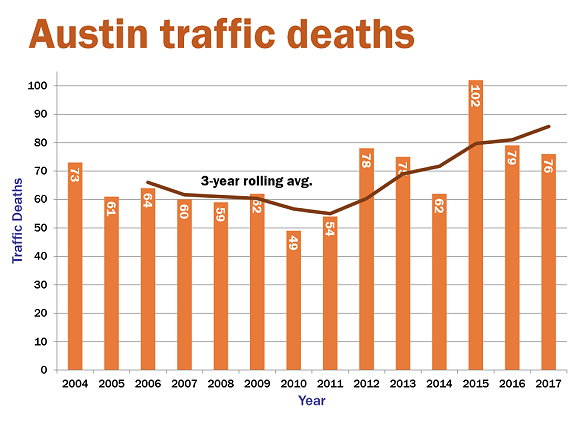 In January 2019, Lewis Leff began as Austin’s first transportation safety officer. The new role signaled the city’s commitment to attaining its Vision Zero policy, aimed at eliminating traffic-related deaths and serious injuries, which was implemented in 2015.
In January 2019, Lewis Leff began as Austin’s first transportation safety officer. The new role signaled the city’s commitment to attaining its Vision Zero policy, aimed at eliminating traffic-related deaths and serious injuries, which was implemented in 2015.The initiative has yielded a mixed bag. The number of traffic fatalities grew from 79 in 2016 to a record 116 in 2021. On the other hand, the number of serious injuries, defined on Austin’s Vision Zero dashboard as any injury that “prevents continuation of normal activities,” dropped from 529 in 2016 to 518 in 2021.
Leff said he knew change in Austin wouldn’t happen overnight, pointing to gradual progress in Sweden, the country that pioneered the Vision Zero model and reduced road fatalities nationwide by roughly 50%-60% over 30 years. “The fact is we’ve got a transportation network that’s been built out for over 80 years, that’s been prioritizing the movement of people in vehicles over everything else, and that particular aspect … doesn’t just change in a year or in five years or whatever. It’s going to take significant time and effort and resources to retrofit that system [to] achieve the policy goals that we put in place as a city, related to people outside of vehicles being able to move around freely and safely as well.”
The number of pedestrians killed on Austin roads consistently ranks second, behind motorists, as the most common travel mode fatality, but in 2022, pedestrian fatalities have outpaced motorist fatalities.
Every June 7, Anna and Eric Bauereis receive an update from Farm & City, a nonprofit that has led road safety efforts, detailing Vision Zero progress. The date marks the anniversary of a driver striking their son, Alexei, when he attempted to cross an intersection on Spicewood Springs Road in Northwest Austin with a friend in 2016.
As with many traffic fatalities, several factors led to Alexei’s death, including speed. “Literally, the kid did have old headlights, a blurry head screen. He was going too fast, you know, just a whole bunch of things that all hit at the wrong time,” Eric said of the driver who hit Alexei. He added that the crosswalk signal did not illuminate at that intersection after a certain hour, even if a pedestrian pressed the button.
Transportation experts cite speed as one of the most important factors in serious crashes. “We always say that speed is the primary factor,” Leff said. City Council is slated to consider changes to speed limits on over 50 roads during its June 16 meeting.
However, the Austin Transportation Department does not manage all roads in Austin, making it critical that the city get buy-in from other road operators, such as the Texas Department of Transportation and the Central Texas Regional Mobility Authority. The roads managed by TxDOT tend to be larger and faster (including I-35 and MoPac) and as a result see the most dangerous crashes. Leff said TxDOT roads have accounted for about 74% of fatalities this year in Austin. He added that ATD is in constant communication with TxDOT about improvements and the two have a great relationship. He noted the city manages traffic lights on TxDOT roads, including the I-35 frontage roads.
TxDOT has a Road to Zero initiative, which aims to cut traffic fatalities in half by 2035 and eliminate them by 2050. The state has this year reduced speeds on some Austin-area roads, including segments of SH 29 in Williamson County, RM 1826 in the southwest, and FM 973 in the east. And it emphasizes three safety priorities – engineering, education, and enforcement – that play a role in reducing speed.
Some mobility advocates say the state transportation agency should do more. Heyden Black Walker, a Safe Streets Austin Board member, said TxDOT needs to design roads for lower speeds. “They’re still building frontage roads at 50 miles an hour, so they say, ‘Oh, well, we’re adding shared-use paths.’ Well, they’re putting a shared-use path next to very high-speed traffic. I mean, they’re designing it for 50, which means a lot of people are actually going faster than 50, and the human body just can’t stand that kind of impact,” Black Walker said.
When the pandemic first ground traffic to halt, many expected the outcome would be fewer fatal car crashes. The opposite happened. Fewer cars on the road left drivers with a greater opportunity to speed and led to more violent crashes. “We’re coming to realize that congestion actually is a limiting factor on speed. It actually can really help,” Black Walker said. “I kind of disagree with the drumbeat that we need to solve congestion for several reasons, but that’s one of them.” She added that while more congestion might lead to more accidents, those accidents tend to be minor because drivers are traveling at lower speeds.
ATD has found success with a few targeted changes in recent years. In 2020 the Vision Zero team identified 13 high-injury roadways where the city implemented low-cost changes, including installing flashing yellow arrows, protected left-turn phasing, and pedestrian head starts at intersections. A city report last year found a 17% decrease in serious injury and fatal crashes on those roadways compared to the previous three-year average. (Leff notes that including serious injuries gives ATD more data to analyze and makes it “easier to see patterns.”)
As for the state roads, Kathy Sokolic, co-founder of Central Texas Families for Safe Streets and a Safe Streets Austin Board member, said advocacy efforts earned a win during the last legislative session. “The one bill that we did get passed in the last few sessions was Stop for Pedestrians; before, [a driver] only had to yield to a pedestrian in a crosswalk, and if you hit them there was no consequence,” she said.
The law was particularly important to her, as she lost a nephew who was hit by a car while crossing a street in the Mueller neighborhood. Sokolic would like to see traffic safety improve, but acknowledges that infrastructure projects move slowly. The city has “put a lot of really great infrastructure in,” Sokolic said. “Pedestrian hybrid beacons that give people a safe place to cross that can stop the traffic. They have reduced speed limits throughout the city. But I think it just takes time.”




